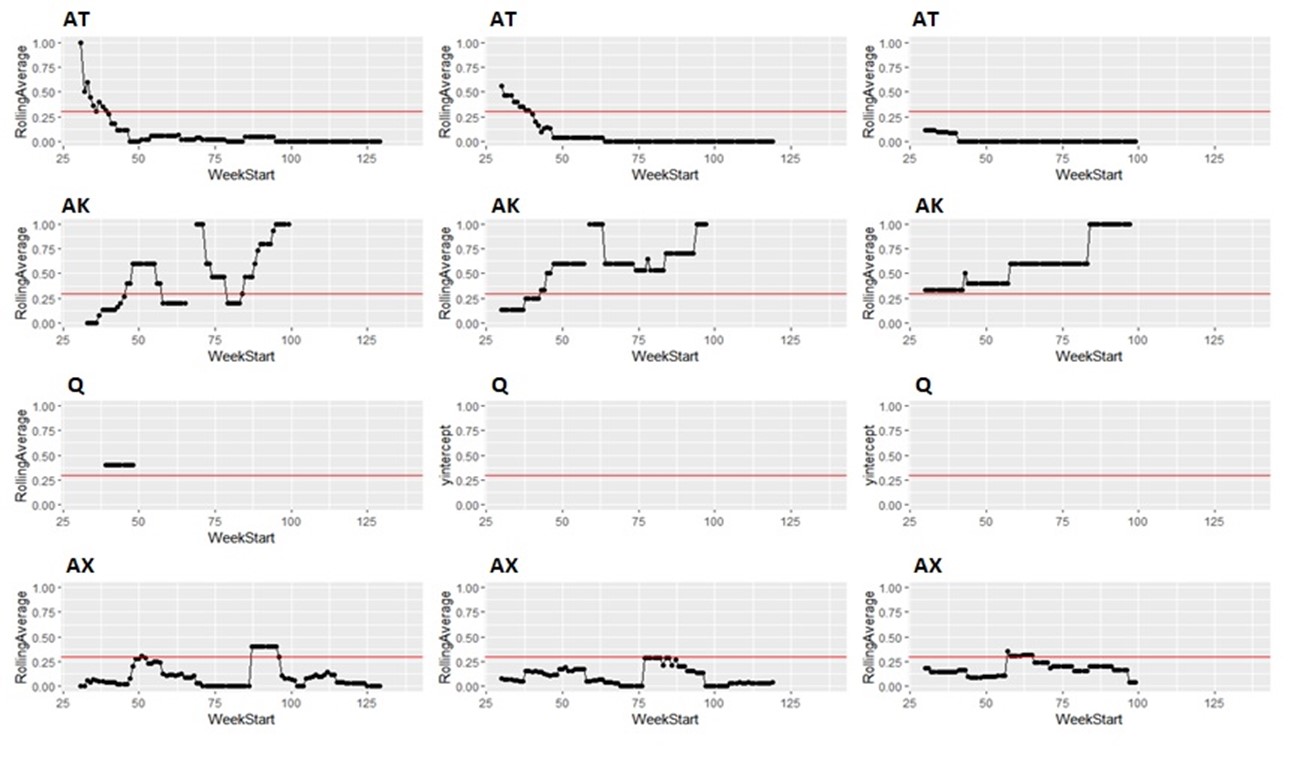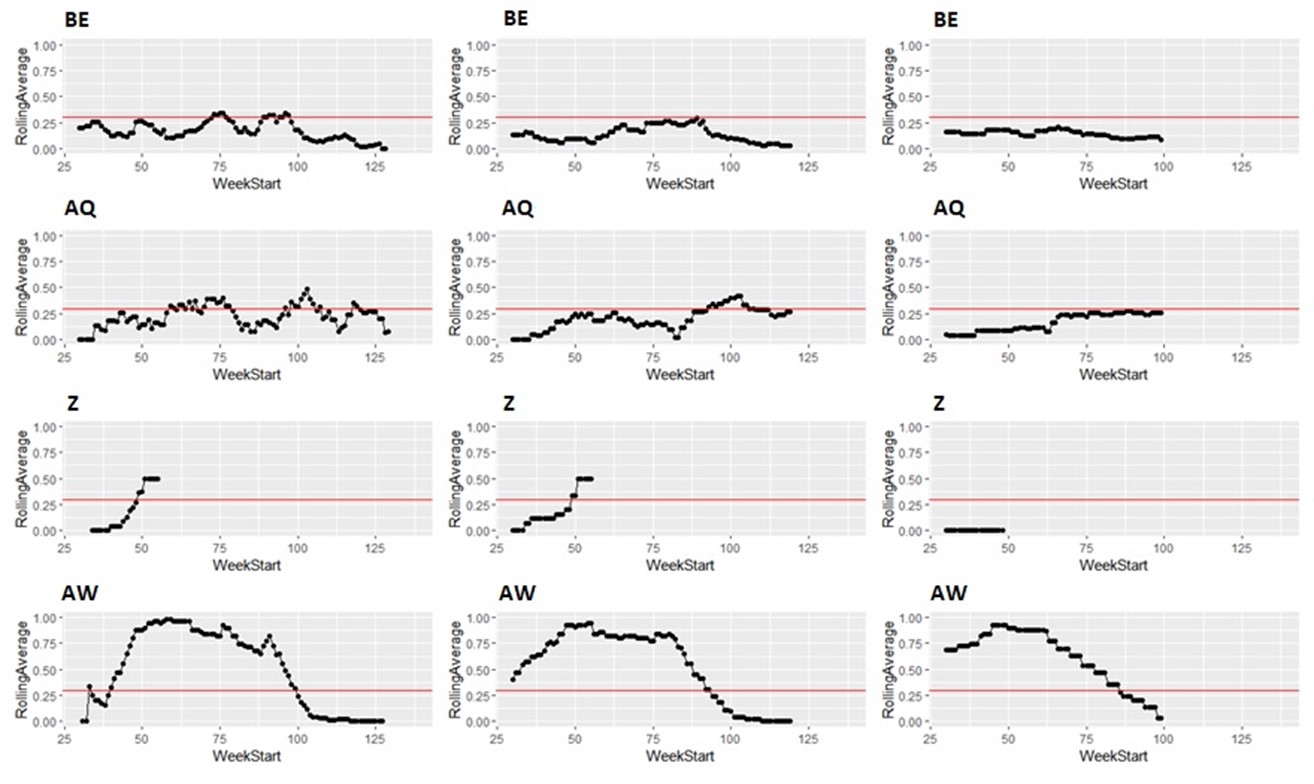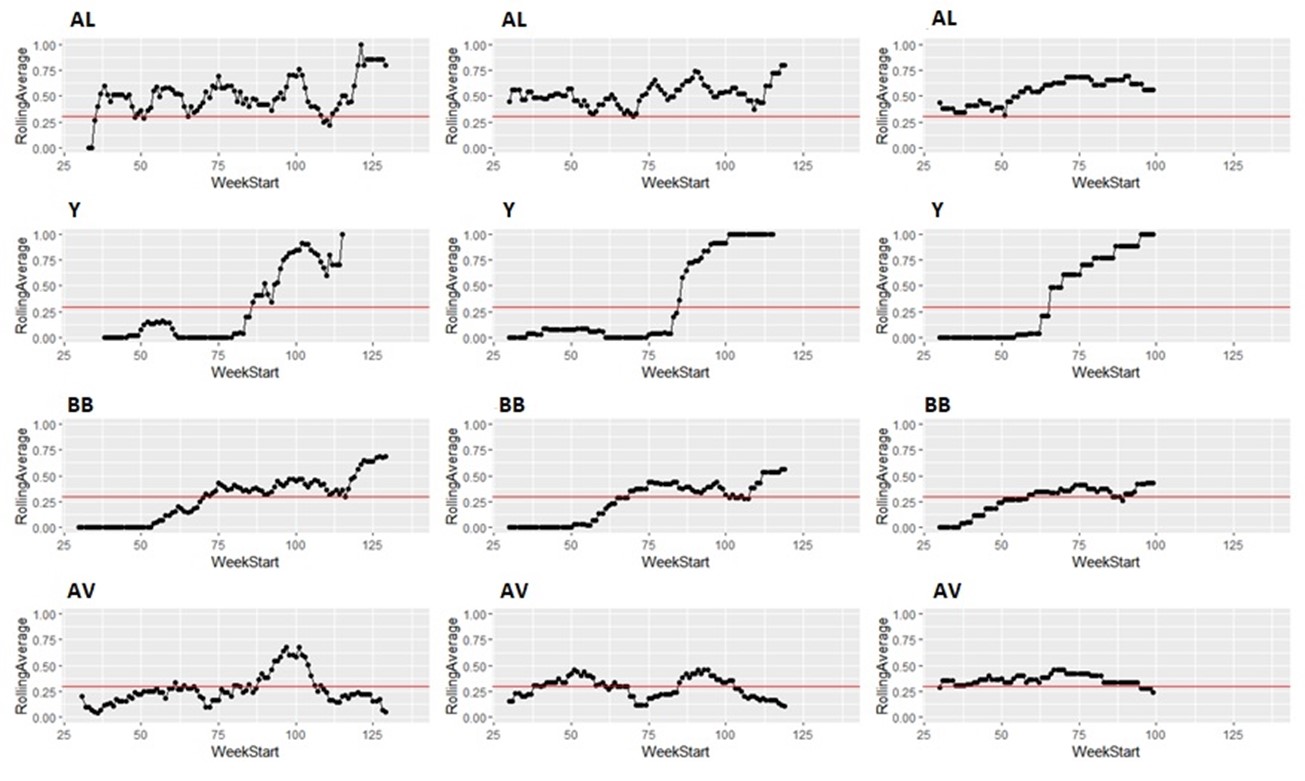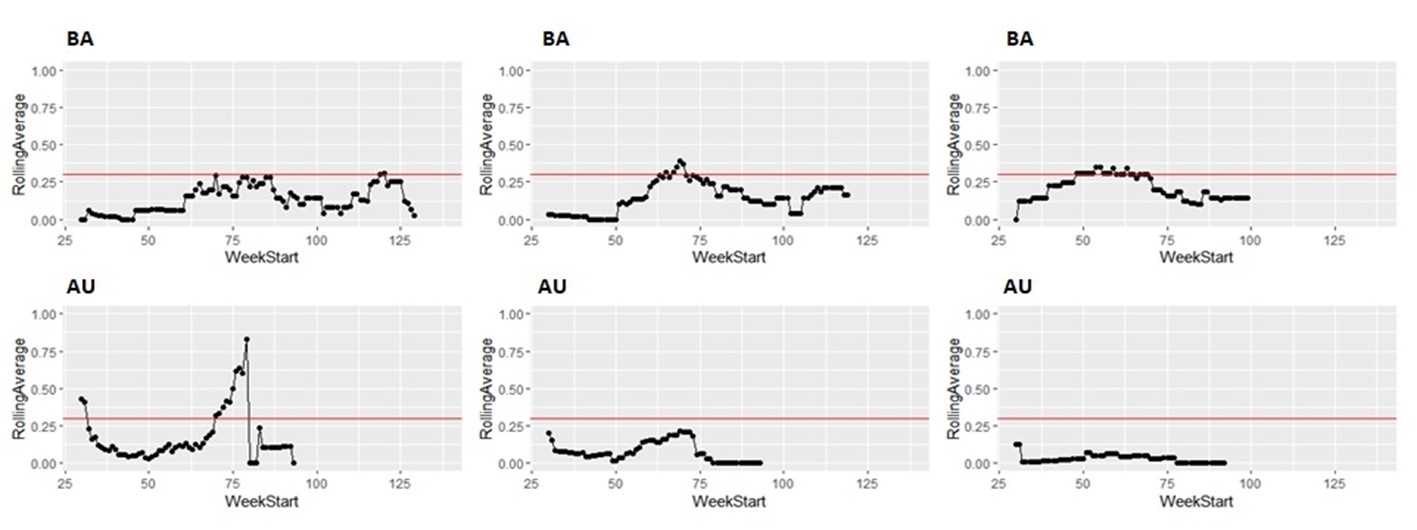Risk of campylobacteriosis from low-throughput poultry slaughterhouses: Risk characterisation
This risk assessment was commissioned to understand the differences in risk from Campylobacter contamination/cross-contamination in slaughterhouses with a low-throughput.
This risk assessment was commissioned to understand the differences in risk from Campylobacter contamination/cross-contamination in slaughterhouses with a low-throughput compared to slaughterhouses with a large throughput and to determine the subsequent risk to human health and the UK population.
The Campylobacter Process Hygiene Criteria were introduced based on the results of a quantitative risk assessment model (Vose Consulting (US) LLC, 2011) that ranked several interventions based on their efficacy for Campylobacter reduction (Retained Commission Regulation (EU) 2017/1495). The EFSA opinion stated that “Theoretically, a public health risk reduction > 50% or > 90% at the EU level could be achieved if all batches that are sold as fresh meat would comply with microbiological criteria with a critical limit of 1000 or 500 CFU/gram of neck and breast skin, respectively” (EFSA Panel on Biological Hazards (BIOHAZ), 2011). Other control options throughout the poultry meat chain are given in Table 2 in Nastasijevic et al., 2020.
The risk pathway for Campylobacter in poultry can be broken down into different stages of the farm to fork process: production (farm), processing (slaughterhouse), post-processing (retail), and home preparation (consumer), where the pathogen levels can increase/decrease.
With regards to the farm module, data from slaughterhouses in relation to different types of poultry processed in slaughterhouses such as conventional, organic, free range, type of cages etc. were limited (uncertainty). Therefore, it was not possible to assess this in this risk assessment.
With regards to Campylobacter levels in slaughterhouses, the literature suggests defeathering and evisceration processes increase the risk of contamination. Controls usually implemented during poultry slaughter to reduce carcase contamination include cleaning and disinfecting equipment such as evisceration machines in addition to the processes of scalding, stream treatment and chilling.
Campylobacter samples were available from 17 low-throughput and 17 high-throughput abattoirs over a 10-week period. Overall, there was no significant difference in the number of highly contaminated samples from low (22%) and high (22%) throughput slaughterhouses after standardisation for number of samples. Enumeration data were available for some low-throughput plants, but high-throughput plants only provide the number of samples above and below 1,000 CFU/g. No data were provided by 26 slaughterhouses.
In terms of individual slaughterhouses and their Campylobacter levels over a 10-week period, the low and high-throughput plants performed in similar ways. Low-throughput slaughterhouses had 5 plants out of 17 with high exceedance levels according to legislation while high-throughput plants had 3 out of 17 exceeding this level. One low-throughput and one high-throughput slaughterhouse had slightly above 60% of their samples exceeding 1,000 CFU/g – the legislation states that this should be no more than 30% or 15 out of 50 samples.
There was also no significant difference between proportions of samples with high levels of Campylobacter from slaughterhouses classed as Halal (30%) and non-Halal (35%) plants.
Most importantly, we were not able to determine whether an exceedance results in mitigative action and specifically what action (uncertainty), whether on-farm or at the abattoir. Therefore, we could not estimate the likely effect of mitigations on Campylobacter levels (uncertainty).
Information was not readily available on the onward distribution of chicken from low and high-throughput slaughterhouses (uncertainty). This distinction could affect the risk – for example, chicken in ready-meals is less likely to cause campylobacteriosis due to being cooked at the manufacturer’s and cooked while sealed at the consumer’s, compared to raw chicken purchased by consumers.
Other surveys of whole chicken at retail found that there was a difference in the proportion of samples with high levels of Campylobacter from small and large retailers but did not find a cause of these differences. However, we were unable to obtain information on the proportion of chicken sold at small and large retailers originating from low-throughput and high-throughput abattoirs. In general, the cold storage chain for fresh retail chicken results in a decrease in Campylobacter levels, estimated to be at least 1 log10 CFU/g.
Whole chicken at small retailers is significantly more likely to have high levels of Campylobacter contamination, compared to that sampled at large retailers. However, we do not have information on whether small retailers are more likely to be supplied by low or high-throughput slaughterhouses (uncertainty).
This risk assessment has only considered chicken slaughtered in the UK as imported chicken is out of scope.
Consumers may be exposed to Campylobacter directly through poultry but also through cross-contamination from other sources of exposure for example, from cooking surfaces. Campylobacter are able to persist both in the environment and in contaminated foods, despite being highly sensitive to atmospheric oxygen concentrations. Washing raw chicken is a key contributor to cross-contamination in domestic settings. Heat treatment which results in a temperature of 70°C for 2 minutes (or equivalent) throughout the part of the product that is slowest to heat would be sufficient to eliminate Campylobacter spp. from the product.
Using data on yearly campylobacteriosis cases (Holland and Mahmoudzadeh, 2020) and the proportion of campylobacteriosis cases attributable to chicken (Oxford University, 2021), we have estimated that 204,000 Campylobacter cases come from chicken, with 11,000 attributed to low-throughput slaughterhouses and 193,000 attributed to high-throughput slaughterhouses.
This strategic risk assessment concluded that given that the proportion of highly contaminated chickens was not significantly different between low and high-throughput slaughterhouses, and under the assumption that the downstream of the slaughterhouses, everything was the same, there is no difference in risk per portion of chicken from each type of slaughterhouse.
One important point to note is that because the proportion of slaughterhouses with high levels of exceedance was not significantly different, the throughput is the main influencing factor when determining the risk to human health and the UK population. We estimated that a total of 9 million highly contaminated birds from small slaughterhouses went to retail each year compared to 168 million from large slaughterhouses. Therefore, Campylobacter cases are much more likely to be linked to chicken produced in large slaughterhouses.
5.1 Risk estimate
Based on suggestions in the ACMSF work on multidimensional representation of risks (ACMSF, 2020), the frequency of occurrence of campylobacteriosis in the UK population from chicken produced in low-throughput slaughterhouses is medium and for high-throughput slaughterhouses is high (see Table 6 for interpretation of the qualitative categories). The uncertainty associated with this probability is medium (see Table 7 for interpretation of the qualitative categories). The risk assessment concludes that the severity of Campylobacter infection is low (see Table 8 for interpretation of the qualitative categories) with low uncertainty.
On a per-portion basis, the frequency of campylobacteriosis from chicken produced in low-throughput slaughterhouses is the same as for high-throughput slaughterhouses.
A number of uncertainties and evidence gaps were identified during this risk assessment. We had no information as to the method in which the poultry were reared prior to arriving at the slaughterhouse and are aware that evidence suggests that this can directly affect Campylobacter levels at slaughter. There was no information available as to the onward processing of meat handled by slaughterhouses, we therefore assumed that low and high-throughput slaughterhouses contribute equally to retail and hospitality etc.
In order to reduce the Campylobacter load on poultry, interventions at the farm and slaughterhouse level in the UK could be assessed for their efficacy to find the methods with the biggest impact. A simpler study could involve gathering information from slaughterhouses with consistently low levels of Campylobacter and sharing their methods as good practice.
Table 6: definition of qualitative categories for probability of occurrence
| Frequency | Interpretation |
|---|---|
| Negligible | So rare that it does not merit to be considered |
| Very low | Very rare but cannot be excluded |
| Low | Rare but does occur |
| Medium | Occurs regularly |
| High | Occurs very often |
| Very high | Events occur almost certainly |
Table 7: definitions of qualitative categories for expressing uncertainty
| Uncertainty category | Interpretation |
|---|---|
| Low | There are solid and complete data available; strong evidence is provided in multiple references; authors report similar conclusions |
| Medium | There are some but no complete data available; evidence is provided in small number of references; authors report conclusions that vary from one another |
| High | There are scarce or no data; evidence is not provided in references but rather in unpublished reports or based on observations, or personal communication; authors report conclusions that vary considerably between them. |
Table 8: definitions of qualitative categories for severity of consequence
| Severity category | Interpretation |
|---|---|
| Negligible | No effects, or so mild they do not merit to be considered |
| Low | Mild illness: not usually life-threatening, usually no sequelae, normally of short duration, symptoms are self-limiting (for example, transient diarrhoea) |
| Medium | Moderate illness: incapacitating but not usually life-threatening, sequelae rare, moderate duration (for example, diarrhoea requiring hospitalisation) |
| High | Severe illness: causing life-threatening or substantial sequelae or illness of long duration (for example, chronic hepatitis) |
5.2 Sampling effect on risk
Part of the scope of this risk assessment is to examine how sampling frequency in low-throughput abattoirs affects the risk, in particular, these four sampling scenarios:
a) Sampling on a weekly basis as per current regulation
b) Not sampling/testing to ascertain compliance with the PHC
c) Sampling every other week
d) Sampling at a rate of once every 4 weeks
Currently, some low-throughput abattoirs submit PHC samples to the FSA and some do not, or do so infrequently.
Regarding the effect of the different proposed sampling scenarios on risk: sampling, in itself, does not directly impact public health unless it triggers control measures that are effective at reducing the frequency or level of Campylobacter contamination. After exceedance of the target threshold there are recommendations for voluntary actions that, in certain combinations, have been found effective, although that effectiveness varies depending on plant-specific factors and their interaction. Given the data gaps that currently exist concerning the probability of voluntary action in the event of exceedance, the types of actions taken either at slaughter or on-farm, and their effectiveness, it is not possible to estimate the reduction in risk such voluntary measures currently produce.
If no testing is undertaken at low-throughput abattoirs the probability of taking voluntary actions as a result of exceedance is automatically zero, although actions may be taken for other reasons. Some low-throughout abattoirs are not testing, therefore the opportunity is lost for any additional measures to be taken. Removing a sampling requirement that is not currently adhered to will not change the risk to public health. Lack of enforcement of mitigations upon failing to comply with the 30% exceedance rate would also mean there is no change in the level of risk.
Taking the same number of samples over a longer period of time (options c and d) would still have some value, as they will still enable identification of high Campylobacter contamination. However, as shown below it is likely to result in substantial differences in the classification of the plants at given points in time, both suggesting that no issue exists when sampling at a normal frequency would suggest an issue exists, as well as the opposite, and delaying the identification of issues.
It is possible to illustrate what results a reduced sampling scheme would have produced, using sampling data from plants that have failed the PHC criteria at some point (Figure 12). For instance, if half the weeks of sampling were to be removed from the original dataset, it would not have been possible to detect 4/14 (29%) of plants that had initially failed to meet the PHC target at some point (second column in Figure 13, Figure 14, Figure 15, Figure 16) at all. If three quarters of the weeks of sampling are removed from the original dataset, it would not have been possible to detect 6/14 (43%) of plants that had initially failed to meet the PHC target at some point (third column in Figure 13, Figure 14, Figure 15, Figure 16) at all. This also assumes that there would be no effect of sampling frequency on behaviours in the plant, for example, that there is no possibility that awareness of less frequent sampling might lead to reduced standards during processing.
It is still possible to detect slaughterhouses that consistently fail, under reduced sampling, such as plants Y, AK, AL, and AW, . It is also possible for a slaughterhouse to perform worse (for example, have a high proportion of samples over 1,000 CFU/g) with a reduced sampling scheme – see plant AK in Figure 13.
Since the rolling average calculation will only be made once every four weeks rather than every week, it would also take longer for issues of high Campylobacter levels to be detected.
In conclusion, because of a lack of consistency in the application of sampling requirements in low-throughput slaughterhouses and a lack of information on the probability and nature of corrective actions taken in the event of an exceedance, it is not possible to differentiate the effect on per-portion risk of changes to current sampling requirements. However, due to the small proportion of total poultry meat consumed in the UK that is produced at low-throughput slaughterhouses, changes to the official requirements for sampling at low-throughput slaughterhouses are unlikely to result in a large change in the total number of cases of campylobacteriosis in the UK population.
Figure 12: Slaughterhouses that at some point failed to meet the PHC target during a 10-week rolling average over 2020-2022. The x axis states the first week of the rolling window, with week 1 of 2020 counting as week 1, week 1 of 2021 counting as week 53 and so on.

Figure 13: Modelling reduced sampling in slaughterhouses. The first column shows the proportion of samples with high levels of Campylobacter at different slaughterhouses that failed the PHC criteria at some point. The effect of reducing the number of samples collected by half is shown in the second column and three-quarters reduction in the third column. The x axis states the first week of the rolling window, with week 1 of 2020 counting as week 1, week 1 of 2021 counting as week 53 and so on.

Figure 14: Modelling reduced sampling in slaughterhouses. The first column shows the proportion of samples with high levels of Campylobacter at different slaughterhouses that failed the PHC criteria at some point. The effect of reducing the number of samples collected by half is shown in the second column and three-quarters reduction in the third column. The x axis states the first week of the rolling window, with week 1 of 2020 counting as week 1, week 1 of 2021 counting as week 53 and so on.

Figure 15: Modelling reduced sampling in slaughterhouses. The first column shows the proportion of samples with high levels of Campylobacter at different slaughterhouses that failed the PHC criteria at some point. The effect of reducing the number of samples collected by half is shown in the second column and three-quarters reduction in the third column. The x axis states the first week of the rolling window, with week 1 of 2020 counting as week 1, week 1 of 2021 counting as week 53 and so on.

Figure 16: Modelling reduced sampling in slaughterhouses. The first column shows the proportion of samples with high levels of Campylobacter at different slaughterhouses that failed the PHC criteria at some point. The effect of reducing the number of samples collected by half is shown in the second column and three-quarters reduction in the third column. The x axis states the first week of the rolling window, with week 1 of 2020 counting as week 1, week 1 of 2021 counting as week 53 and so on.

5.3 Uncertainties and assumptions
The following are key uncertainties or data gaps in order of importance:
- differences in onward processing and supply of carcases provided by low and high-throughput slaughterhouses to other businesses
- differences in the rearing of poultry provided to low and high-throughput slaughterhouses
- the distribution of Campylobacter enumeration levels in high-throughput slaughterhouses
- the amount of poultry imported into the UK for UK consumption and exported by low and high-throughput slaughterhouses
- Campylobacter levels at the 5 high and 21 low-throughput slaughterhouses where no results were available
The following are assumptions made in this report:
- there is no difference in the poultry that is supplied to low- and high-throughput slaughterhouses
- carcases from low and high-throughput slaughterhouses are provided in similar proportions to retail, caterers, exporters etc.
- the distribution of detectable Campylobacter levels in high-throughput slaughterhouses is similar to that of low-throughput slaughterhouses
- there is no difference in the population of consumers eating chicken from high and low-throughput slaughterhouses
- that the proportion of the total domestic consumption of poultry meat originating from low-throughput slaughterhouses does not change
Data gaps
This report focuses predominantly on chicken as being most consumed – but the abattoirs in question also process turkey broilers.
5.4 Recommendations for future research
The most important evidence gap for reducing uncertainty in this assessment is gaining a better understanding of the probability that action is taken, and the nature of the action(s) taken, in response to exceedance, as well as their effectiveness. This will likely be achieved by a survey of the FBOs, official veterinarians and meat hygiene inspectors working at the premises.
It would also be useful to understand the differences in prevalence and levels of Campylobacter on poultry entering the slaughterhouse. This could be potentially achieved by combining information on the types of farms supplying each category of slaughterhouses, the farm management practices in use on each and information on the levels of Campylobacter on farm, or by additional microbiological sampling of chickens at entry into the slaughterhouse.
It would be useful to understand what products the outputs of each plant type are used for for example, chicken portions, whole chickens, retail, catering, etc. as well as how effectively each of these products are cooked; for example, meat thermometers are more likely to be used during commercial cooking steps. This would be achieved with an FBO survey.
Hanes diwygio
Cyhoeddwyd: 23 Mehefin 2023
Diweddarwyd ddiwethaf: 24 Mehefin 2024
Hanes diwygio
Cyhoeddwyd: 23 Mehefin 2023
Diweddarwyd ddiwethaf: 24 Mehefin 2024